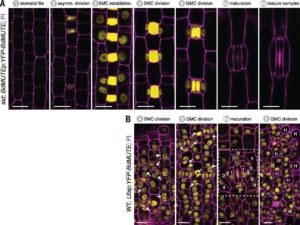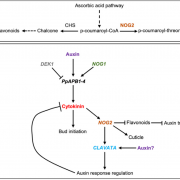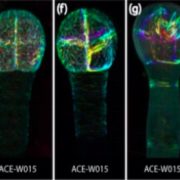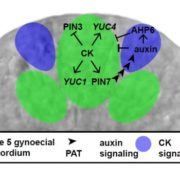Mobile MUTE specifies subsidiary cells to build physiologically improved grass stomata ($)
 Plants breathe through pores called stomata on leaf surfaces. Stomata are the point of contact with the outside world as they allow gas exchange (e.g., CO2 for photosynthesis) and transpiration. Grasses have evolved to form more efficient stomata in which the guard cells are flanked by additional subsidiary cells. Therefore, grasses form superior 4-celled stomata for efficient functioning; stomata can open wider or close faster in response to varying conditions. Starting with a loss-of-function mutant subsidiary cell identity defective (sid), Raissig et al. describe how in the model grass Brachypodium distachyon a transcription factor called MUTE physically moves from guards cells to adjacent cells to recruit them for formation of the 4-celled stomata complex. The corresponding MUTE protein from Arabidopsis does not move between cells and fails to rescue the loss-of-function sid mutant. (Summary by Nidhi Sharma) Science 10.1126/science.aal3254
Plants breathe through pores called stomata on leaf surfaces. Stomata are the point of contact with the outside world as they allow gas exchange (e.g., CO2 for photosynthesis) and transpiration. Grasses have evolved to form more efficient stomata in which the guard cells are flanked by additional subsidiary cells. Therefore, grasses form superior 4-celled stomata for efficient functioning; stomata can open wider or close faster in response to varying conditions. Starting with a loss-of-function mutant subsidiary cell identity defective (sid), Raissig et al. describe how in the model grass Brachypodium distachyon a transcription factor called MUTE physically moves from guards cells to adjacent cells to recruit them for formation of the 4-celled stomata complex. The corresponding MUTE protein from Arabidopsis does not move between cells and fails to rescue the loss-of-function sid mutant. (Summary by Nidhi Sharma) Science 10.1126/science.aal3254









